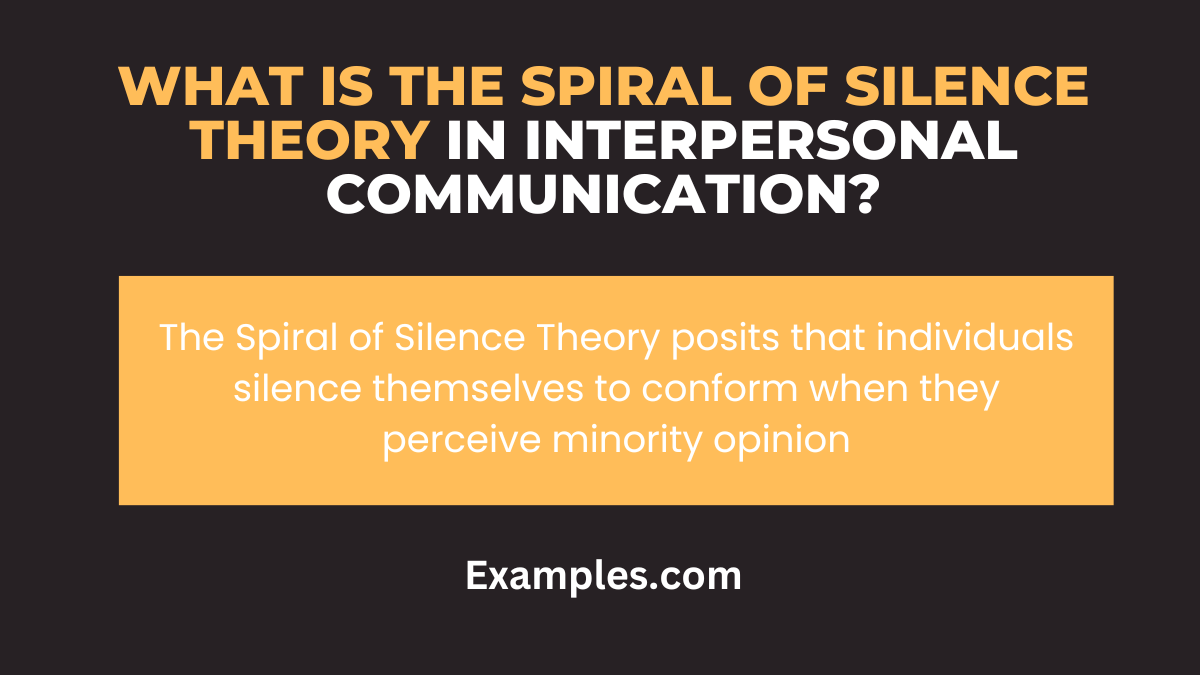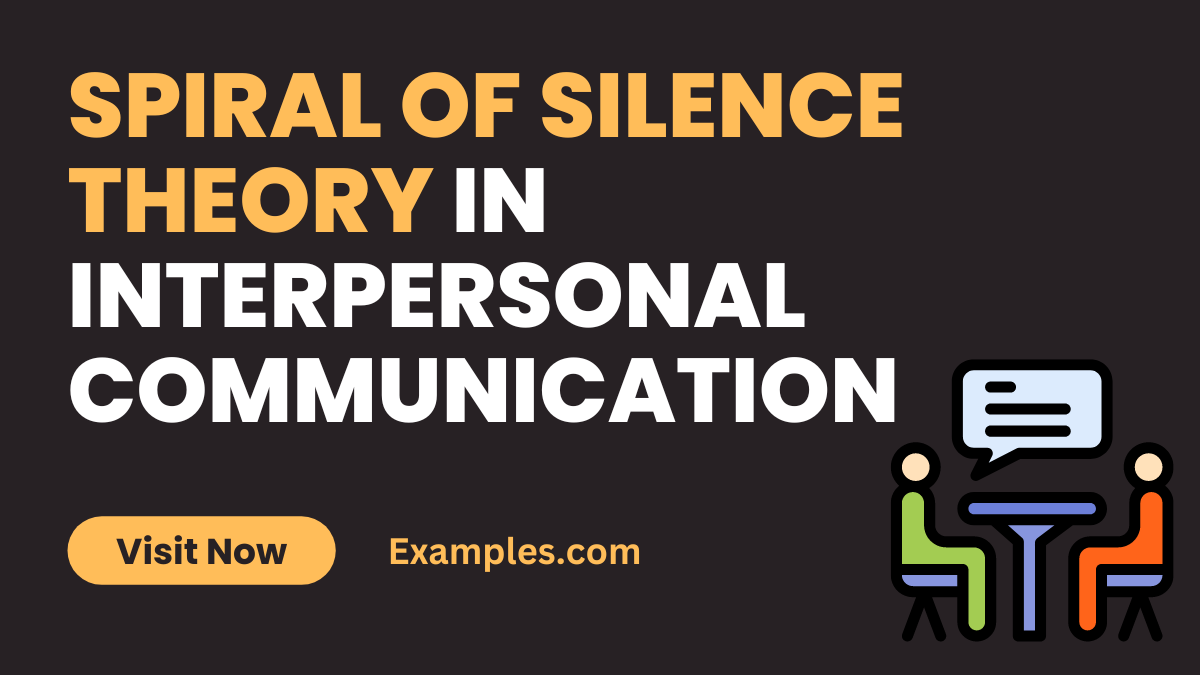19+ Spiral of Silence Theory in Interpersonal Communication Examples
Unlock the secrets of the Spiral of Silence Theory in Interpersonal Communication with this comprehensive guide. Delve into the intricate dynamics of social influence and how it shapes our conversations. Learn how this theory explains the tendency of individuals to remain silent when they feel their views are in opposition to the majority, impacting our everyday interactions. Perfect for students, educators, and professionals, this guide offers insightful analysis and practical applications of this pivotal communication theory.
What is the Spiral of Silence Theory in Interpersonal Communication?

The Spiral of Silence Theory, conceived by German political scientist Elisabeth Noelle-Neumann in the 1970s, explores the phenomenon of people choosing not to express their opinions when they perceive they are in the minority. This theory is pivotal in understanding how public opinion is formed and how individuals communicate within a group setting. It posits that individuals have a “quasi-statistical organ,” a sixth sense, which gauges the prevailing public opinion, influencing whether they decide to voice their opinions or remain silent.
History
Who Created: Elisabeth Noelle-Neumann
Date: 1974
Her background in public opinion research led her to observe how people’s fear of isolation and social rejection leads to silence, especially when their opinions differ from the majority view. This theory has since become a cornerstone in the study of mass communication and public opinion, influencing various aspects of Interpersonal Communication.
What is the Best Example of Spiral of Silence Theory in Interpersonal Communication?
A classic example of the Spiral of Silence Theory in action can be observed in workplace meetings. Often, employees may refrain from voicing their true opinions or innovative ideas due to the fear of being judged or alienated by their colleagues and superiors. This fear is heightened if the dominant opinion in the room is contrary to their own. As a result, these individuals choose silence over expression, which can lead to a lack of diversity in ideas and perspectives within the organization.
20 Examples of Spiral of Silence Theory in Interpersonal Communication

The Spiral of Silence Theory in Interpersonal Communication underscores the tendency of individuals to mute their opinions if they perceive themselves as holding a minority view, due to fear of social exclusion. This phenomenon is critical in understanding various Types of Interpersonal Communication, particularly in contexts like Public Communication and Interpersonal Conflict Communication. Recognizing this behavior is vital in comprehending how opinions are formed and expressed within groups and in diverse interpersonal settings.
- Avoiding discussion on sensitive topics at work:
“I’d rather not talk about my views on this policy; they might not agree.”
An employee chooses not to share their thoughts on workplace policies to avoid potential disagreement. - Staying quiet about personal beliefs in a social group:
“I don’t think they’ll understand my perspective, so I won’t bring it up.”
A person refrains from expressing their beliefs among friends, fearing judgment or alienation. - Not voicing disagreement in a family debate:
“It’s better to stay silent than to start an argument over this issue.”
Choosing not to express a differing opinion in family discussions to maintain harmony. - Withholding opinions in a classroom setting:
“My thoughts on this topic are different, but I don’t want to stand out.”
A student decides not to share their unique perspective to avoid feeling isolated. - Silence in online forums on controversial subjects:
“I have a lot to say, but it might not be well-received here.”
Opting not to engage in online discussions on contentious topics to avoid backlash. - Not expressing dietary preferences in a new group:
“They all eat meat; they might find my vegetarianism odd.”
Someone might not disclose their dietary choices in a social setting to avoid being different. - Avoiding political conversations in mixed company:
“Politics can be divisive; I’d rather not get into it.”
Steering clear of political discussions in diverse groups to prevent conflict. - Holding back creative ideas in a team project:
“My idea is unconventional; they might not take it well.”
A team member refrains from suggesting innovative ideas, fearing they won’t be accepted. - Not sharing personal experiences in group therapy:
“My story is too different; others might not relate to it.”
Choosing not to share in group therapy sessions, worried about being misunderstood. - Remaining silent on social issues among colleagues:
“Bringing up this social issue might make my coworkers uncomfortable.”
Avoiding discussions on social issues at work to keep the peace. - Not correcting misconceptions in a community meeting:
“If I correct them, I might be seen as argumentative.”
Deciding not to correct misinformation in public settings to avoid seeming confrontational. - Withholding artistic preferences in a class:
“They all like modern art; my interest in classical art might seem odd.”
A student doesn’t share their distinct taste in art to fit in with classmates. - Not participating in debates on environmental issues:
“I have strong views on this, but it’s safer to stay quiet.”
Choosing not to voice opinions in debates on environmental concerns due to fear of opposition. - Staying quiet about achievements in a competitive environment:
“I don’t want to seem boastful or different by sharing my success.”
Downplaying personal accomplishments to avoid standing out. - Silence during team feedback sessions:
“I have suggestions, but I don’t want to upset the team dynamic.”
Employees might hold back feedback to maintain group cohesion. - Avoiding cultural discussions in a diverse setting:
“Discussing cultural differences might be too sensitive here.”
Not engaging in conversations about cultural differences to prevent potential offense. - Not expressing musical preferences among peers:
“My music taste is different; better not to share it.”
Keeping musical tastes private in a peer group to avoid being judged. - Silence on personal values in a relationship:
“It’s better not to discuss this value conflict to keep the peace.”
Choosing not to share conflicting personal values in a romantic relationship. - Not voicing concerns about community issues:
“I don’t want to be the only one opposing this community decision.”
Withholding opinions on local community matters to avoid being the lone dissenting voice. - Avoiding participation in public opinion polls:
“My views might be too unpopular; I won’t participate in this survey.”
Choosing not to partake in surveys or polls for fear of being judged.
Perspectives of Spiral of Silence Theory in Interpersonal Communication
- Fear of Isolation: This theory proposes that individuals are less likely to express their opinions if they believe they are in the minority, due to fear of being isolated or ostracized from the group.
- Public Opinion as Dominant Force: It views public opinion as a powerful influence that can shape an individual’s willingness to express personal views, particularly in Interpersonal Communication.
- Assessment of the Climate: Individuals continuously gauge the climate of opinion to determine the prevailing view. This assessment influences their decision to speak out or stay silent.
- Quasi-Statistical Sense: This refers to the intuitive judgment individuals make regarding the prevalent opinion and its favorability towards their view.
- Role of Mass Media: The theory underscores the significant role of mass media in forming a dominant opinion, which then influences interpersonal exchanges.
- Time Factor: Over time, views perceived to be in the minority lose ground as fewer people express them in public settings.
- Social Backdrop: The cultural, political, and social context plays a crucial role in how opinions are formed and expressed.
- Personal Experiences and Characteristics: Individual experiences and personality traits can impact the likelihood of someone engaging in self-censorship or openly sharing their views.
What are the Advantages of Spiral of Silence Theory in Interpersonal Communication?
| Advantage | Explanation |
|---|---|
| Promotes Social Harmony | By encouraging individuals to align with majority opinions, it can lead to a more harmonious social environment. |
| Enhances Awareness | Makes individuals more cognizant of the prevailing opinions, thereby enhancing their understanding of social dynamics in communication. |
| Guides Communication Strategies | Helps in strategizing communication approaches based on the assessment of majority views. |
| Facilitates Conflict Avoidance | By identifying potentially controversial opinions, individuals can avoid conflicts in interpersonal settings. |
| Encourages Attentive Listening | Promotes active listening to understand the majority opinion, a key aspect of effective Interpersonal Communication. |
| Influences Public Opinion Formation | Plays a role in shaping public opinion, which is integral to societal dynamics. |
| Reflects Cultural Sensitivity | Highlights the importance of cultural contexts in shaping opinions and communication styles. |
| Guides Media Consumption | Influences how individuals interpret and respond to media content in the context of interpersonal discussions. |
Main Assumptions of Spiral of Silence Theory in Interpersonal Communication
- Fear of Social Isolation: The primary assumption is that people have a natural fear of being socially isolated due to their opinions.
- Society’s Threat: Society threatens deviant individuals with isolation; people, therefore, try to sense the climate of opinion at all times.
- Cyclical Process: As minority opinions are less expressed, they seem to be more minority, creating a downward spiral in their expression.
- Media’s Powerful Role: Assumes a significant role of mass media in shaping what is considered the dominant or majority opinion.
- Plurality of Opinions at Outset: Initially, there is a plurality of opinions before the spiral of silence begins to take effect.
- Time and Context Relevance: The relevance and intensity of the theory can vary over time and across different cultural or social contexts.
- Personal Characteristics Impact: Assumes that people’s willingness to express minority opinions can be affected by their personal characteristics, such as self-esteem and assertiveness.
- Dynamic Nature of Public Opinion: Recognizes that public opinion is not static but is constantly evolving, influenced by various factors including media and interpersonal exchanges.
Spiral of Silence Theory in Interpersonal Communication is crucial. By following these tips and guidelines, you can effectively write about this theory. Remember to engage your audience with clear, concise explanations and foster a sense of inclusivity. Keep the conversation flowing, encouraging open dialogue, and promoting a deeper understanding of this essential concept in communication.



